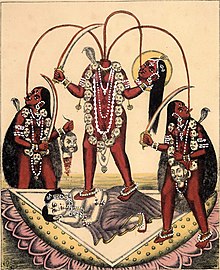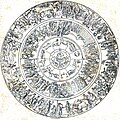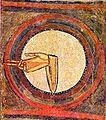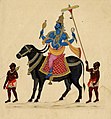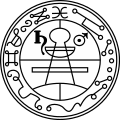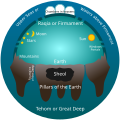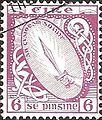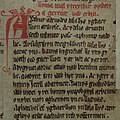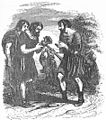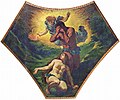The Myths Portal

Myth is a genre of folklore consisting primarily of narratives that play a fundamental role in a society. For scholars, this is very different from the vernacular usage of the term "myth" that refers to a belief that is not true. Instead, the veracity of a myth is not a defining criterion.
Myths are often endorsed by secular and religious authorities and are closely linked to religion or spirituality. Many societies group their myths, legends, and history together, considering myths and legends to be factual accounts of their remote past. In particular, creation myths take place in a primordial age when the world had not achieved its later form. Origin myths explain how a society's customs, institutions, and taboos were established and sanctified. National myths are narratives about a nation's past that symbolize the nation's values. There is a complex relationship between recital of myths and the enactment of rituals. (Full article...)
Selected article -
Chhinnamasta (Sanskrit: छिन्नमस्ता, Chinnamastā :"She whose head is severed"), often spelled Chinnamasta, and also called Chhinnamastika and Prachanda Chandika and Jogani Maa (in western states of India), is a Hindu goddess (Devi). She is one of the Mahavidyas, ten goddesses from the esoteric tradition of Tantra, and a ferocious aspect of Mahadevi, the Hindu Mother goddess. The self-decapitated nude goddess, usually standing or seated on a divine copulating couple, holding her own severed head in one hand and a scimitar in another. Three jets of blood spurt out of her bleeding neck and are drunk by her severed head and two attendants.
Chhinnamasta is a goddess of contradictions. She symbolises both aspects of Devi: a life-giver and a life-taker. She is considered both a symbol of sexual self-control and an embodiment of sexual energy, depending upon interpretation. She represents death, temporality, and destruction as well as life, immortality, and recreation. The goddess conveys spiritual self-realization and the awakening of the kundalini – spiritual energy. The legends of Chhinnamasta emphasise her self-sacrifice – sometimes coupled with a maternal element – sexual dominance, and self-destructive fury. (Full article...)Did you know? -
- ... that the demon Maha Sohona, whose head has been replaced with that of a bear, haunts graveyards and feasts on human flesh?
- ... that according to Hindu mythology, the "first king" Prithu chased the Earth in the form of a cow (pictured), who eventually agreed to yield her milk as all the world's grain and vegetation?
- ...that according to Inca mythology, lunar eclipses are caused by animals attacking Mama Quilla, the goddess of the moon?
- ... that Xiuhtecuhtli (mask pictured), the Aztec god of fire, was one of the nine Lords of the Night even though he was a solar deity?
Recognised content
Featured Articles:
![]() Ahalya,
Ahalya, ![]() Ancient Egyptian literature,
Ancient Egyptian literature, ![]() King Arthur,
King Arthur, ![]() Ganesha,
Ganesha, ![]() Iravan,
Iravan, ![]() Orion (mythology),
Orion (mythology), ![]() Vampire,
Vampire, ![]() Vithoba
Vithoba
Featured Lists:
![]() List of valkyrie names in Norse mythology
List of valkyrie names in Norse mythology
Good Articles:
![]() 2012 phenomenon,
2012 phenomenon,
![]() Æsir–Vanir War,
Æsir–Vanir War,
![]() Ala (demon),
Ala (demon),
![]() Anu,
Anu,
![]() Aphrodite,
Aphrodite,
![]() Athena,
Athena,
![]() Ardhanarishvara,
Ardhanarishvara,
![]() Battle of Barry,
Battle of Barry,
![]() Bhikshatana,
Bhikshatana,
![]() Catalogue of Women,
Catalogue of Women,
![]() Chamunda,
Chamunda,
![]() Chhinnamasta,
Chhinnamasta,
![]() Consorts of Ganesha,
Consorts of Ganesha,
![]() Cú Chulainn,
Cú Chulainn,
![]() Dhumavati,
Dhumavati,
![]() Dumuzid,
Dumuzid,
![]() Einherjar,
Einherjar,
![]() Eir,
Eir,
![]() Enlil,
Enlil,
![]() Fairy Flag,
Fairy Flag,
![]() Fenrir,
Fenrir,
![]() Gerðr,
Gerðr,
![]() Hel (being),
Hel (being),
![]() Huginn and Muninn,
Huginn and Muninn,
![]() Iðunn,
Iðunn,
![]() Ila (Hinduism),
Ila (Hinduism),
![]() Inanna,
Inanna,
![]() Kabandha,
Kabandha,
![]() Kali,
Kali,
![]() Kamadhenu,
Kamadhenu,
![]() Kangiten,
Kangiten,
![]() Keshi (demon),
Keshi (demon),
![]() Khandoba,
Khandoba,
![]() Kratos (mythology)
Kratos (mythology)
![]() Krishna,
Krishna,
![]() Kubera,
Kubera,
![]() LGBT themes in Hindu mythology,
LGBT themes in Hindu mythology,
![]() Manasa,
Manasa,
![]() Mandodari,
Mandodari,
![]() Matangi,
Matangi,
![]() Matrikas,
Matrikas,
![]() Maya Sita,
Maya Sita,
![]() Mohini,
Mohini,
![]() Myrrha,
Myrrha,
![]() Mythology of Carnivàle,
Mythology of Carnivàle,
![]() Naraka (Hinduism),
Naraka (Hinduism),
![]() Ninurta,
Ninurta,
![]() Prester John,
Prester John,
![]() Prithu,
Prithu,
![]() Putana,
Putana,
![]() Rati,
Rati,
![]() Ratatoskr,
Ratatoskr,
![]() Revanta,
Revanta,
![]() Satyavati,
Satyavati,
![]() Satyr,
Satyr,
![]() Sharabha,
Sharabha,
![]() Shashthi,
Shashthi,
![]() Shiva,
Shiva,
![]() Sif,
Sif,
![]() Tara (Ramayana),
Tara (Ramayana),
![]() Troilus,
Troilus,
![]() Tuisto,
Tuisto,
![]() Valhalla,
Valhalla,
![]() Valkyrie,
Valkyrie,
![]() Vampire folklore by region,
Vampire folklore by region,
![]() Varaha,
Varaha,
![]() Varahi,
Varahi,
![]() Veðrfölnir and eagle
Veðrfölnir and eagle
![]() Zduhać
Zduhać
Wikiversity
Selected creature -

The nuckelavee ( /nʌklɑːˈviː/) or nuckalavee is a horse-like demon from Orcadian folklore that combines equine and human elements. British folklorist Katharine Briggs called it "the nastiest" of all the demons of Scotland's Northern Isles. The nuckelavee's breath was thought to wilt crops and sicken livestock, and the creature was held responsible for droughts and epidemics on land despite being predominantly a sea-dweller.
A graphic description of the nuckelavee as it appears on land was given by an islander who claimed to have had a confrontation with it, but accounts describing the details of the creature's appearance are inconsistent. In common with many other sea-monsters, it is unable to tolerate fresh water, therefore, those it is pursuing have only to cross a river or stream to be rid of it. The nuckelavee is kept in confinement during the summer months by the Mither o' the Sea, an ancient Orcadian spirit, and the only one able to control it. (Full article...)General images
Subcategories
WikiProjects
Things you can do
- Help with the myth and folklore missing articles project.
- Help create requested articles.
- Help assessment at Wikipedia:WikiProject Mythology/Assessment.
- Place the project banner ((WikiProject Mythology)) on the talk pages of all relevant articles.
- Check the recent changes for recent improvements, vandalism, and other changes.
- Answer requests for mythology articles needing attention: Category:Mythology articles needing attention
- Answer requests for mythology articles needing expert attention: Category:Mythology articles needing expert attention
- Expand articles tagged as mythology stubs: Category:Mythology stubs
- Assist mythology subprojects.
- Add requested photographs of mythology subjects: Category:Wikipedia requested photographs of mythology subjects
Associated Wikimedia
The following Wikimedia Foundation sister projects provide more on this subject:
-
Commons
Free media repository -
Wikibooks
Free textbooks and manuals -
Wikidata
Free knowledge base -
Wikinews
Free-content news -
Wikiquote
Collection of quotations -
Wikisource
Free-content library -
Wikiversity
Free learning tools -
Wiktionary
Dictionary and thesaurus
